- The cost of the Cross Bar switch grows
n2 (quadratically)
with the number of inputs
(and outputs) n
- There is a class of switching fabric that grows in the order of n log(n) with the number of inputs (and outputs) n
- A 2x2 Banyan switch has two inputs
- numbered 0 and 1
and two outputs
- numbered 0 and 1
- Banyan switch:
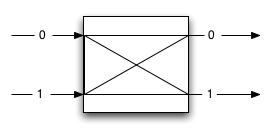
- The Banyan switch
has a switching control built
into the switch itself:
- Every
information unit
that comes into the
Banyan switch has a
header
that contains
a bit indicating its
destination
(either 0 or 1).
The header is usually the first bit of the packet (message)
- If the switch reads the bit and it has value
0,
it
sends the packet to its upper output
(which is marked with 0 in the figure)
- If the switch reads the bit and it has value 1, it sends the packet to its lower output (which is marked with 1 in the figure)
- Every
information unit
that comes into the
Banyan switch has a
header
that contains
a bit indicating its
destination
(either 0 or 1).
- By connecting these simple Banyan switching elements in series and parallel, it is possible to route packets in more complicated ways depending on the desired routes to establish.
- The
Delta Interconnection Network
is a
digit controlled multi-stage
interconnection network
made up with Banyan Switches
- Here is an example of a
8x8 Delta Network
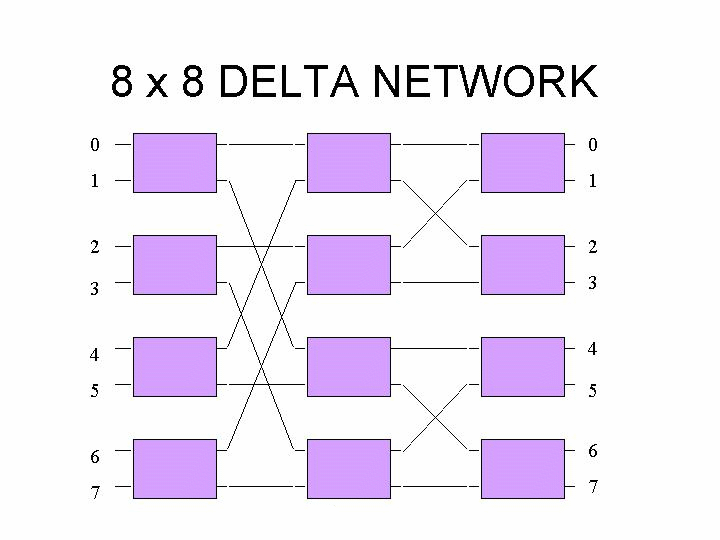
- Each rectangle represents a
2x2 Banyan Switch
- A request from the source to the destination
will be transmitted as follows:
100aaaaaaaaaaaaaaaaaaaaaaaaaaaaaaaaaa +++********************************** ^ |<------------------------------>| | Address value (data) | Routing information - The first bit
is used to control the
Banyan Switching fabric
- After making routing decision, the Banyan Switching removes the routing (first) bit and the rest of the message is forwarded to the next stage.
- Example:
- CPU 1
wants to send an address value to
Memory Module 4
- 4 = 100
- CPU 1
wants to send an address value to
Memory Module 4
- Step 1 of the transmission:
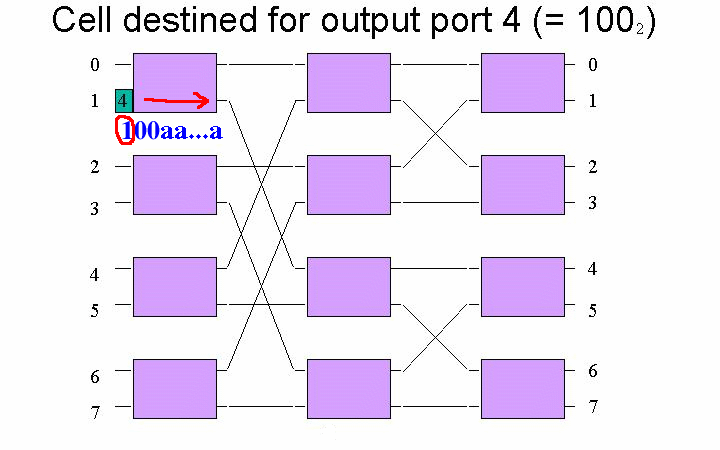
Because the routing (first) bit is 1 , the entire message (except the routing bit) is forwarded onto the lower connection
- Step 2 of the transmission:

Because the routing (first) bit is 0 , the entire message (except the routing bit) is forwarded onto the upper connection
- Step 3 of the transmission:
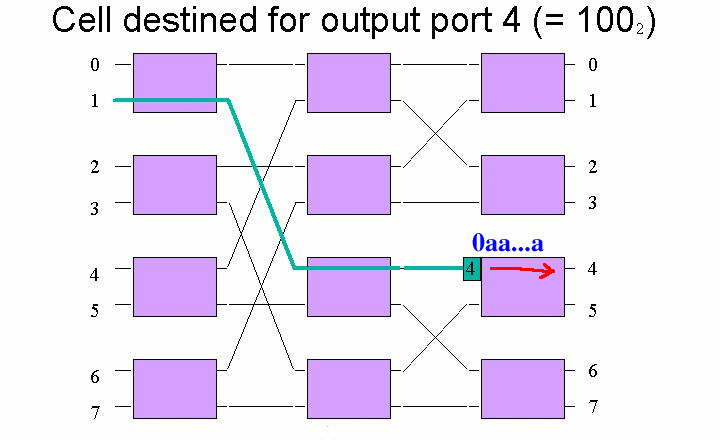
Because the routing (first) bit is 0 , the entire message (except the routing bit) is forwarded onto the upper connection
- The address value is then "delivered" (connected) to the memory module 4
- Example:
- CPU 6
wants to send an address value to
Memory Module 4
- 4 = 100
- CPU 6
wants to send an address value to
Memory Module 4
- Step 1 of the transmission:

Because the routing (first) bit is 1 , the entire message (except the routing bit) is forwarded onto the lower connection
- Step 2 of the transmission:
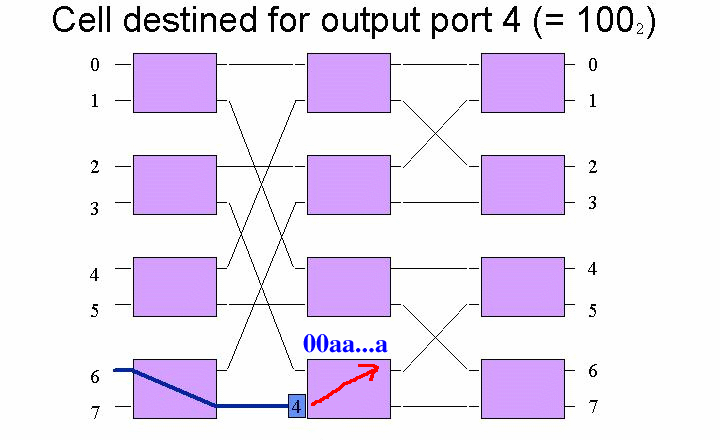
Because the routing (first) bit is 0 , the entire message (except the routing bit) is forwarded onto the upper connection
- Step 3 of the transmission:
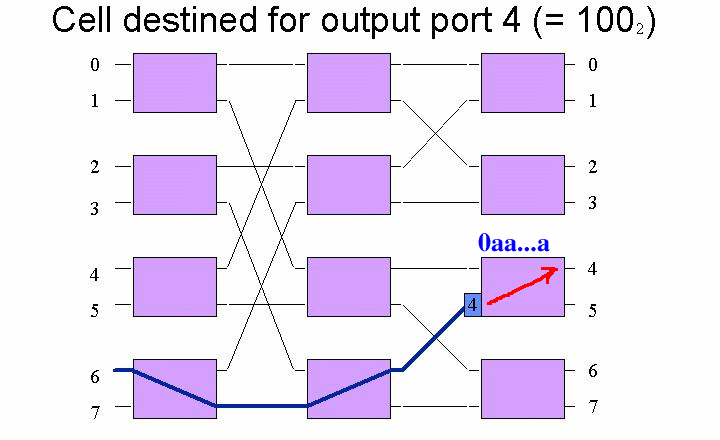
Because the routing (first) bit is 0 , the entire message (except the routing bit) is forwarded onto the upper connection
- The address value is then "delivered" (connected) to the memory module 4
- Multiple requests
can be routed
simultaneously
through the Delta Network
- Example:
- CPU 1
wants to send an address value to
Memory Module 5
(5 = 101 )
- CPU 3 wants to send an address value to Memory Module 7 (7 = 111 )
- CPU 1
wants to send an address value to
Memory Module 5
(5 = 101 )
- Step 1:
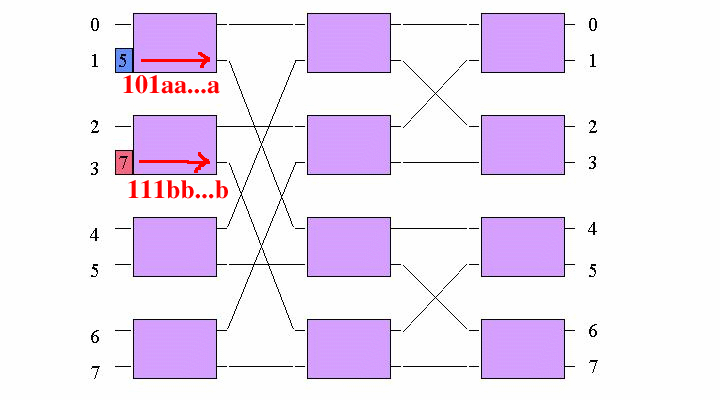
- Step 2:
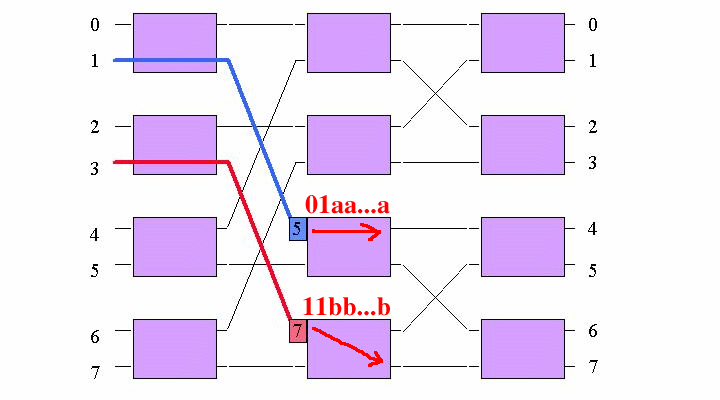
- Step 3:
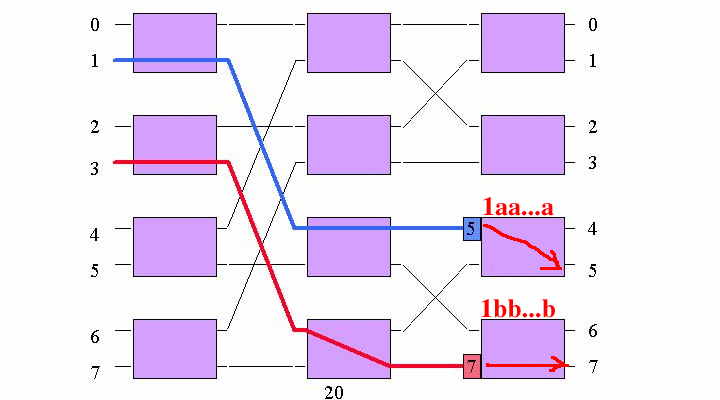
- Example:
- CPU 1
wants to send an address value to
Memory Module 5
(5 = 101 )
- CPU 3
wants to send an address value to
Memory Module 7
(7 = 111 )
- CPU 6 wants to send an address value to Memory Module 1 (1 = 001 )
- CPU 1
wants to send an address value to
Memory Module 5
(5 = 101 )
- Step 1:
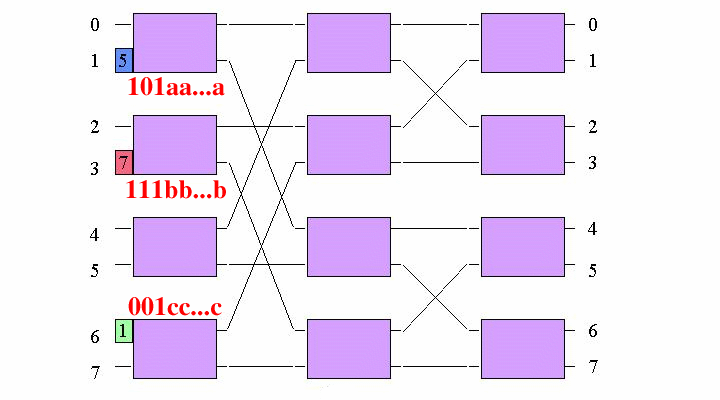
- Step 2:
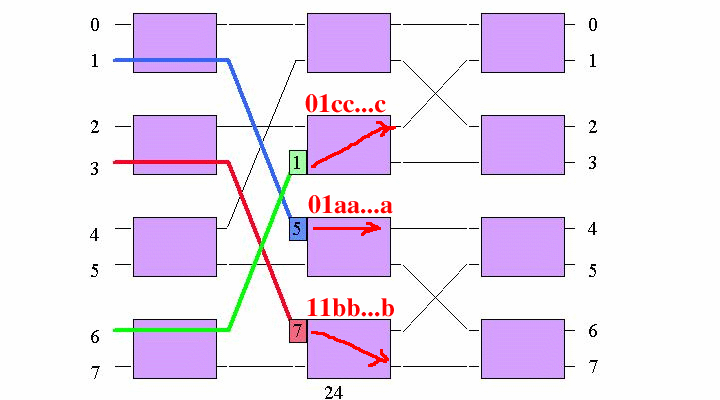
- Step 3:
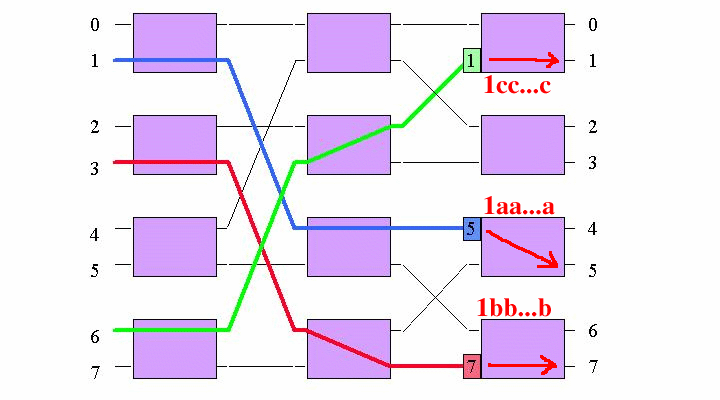
- Just like in the Cross Bar switch, if
multiple CPUs
request to access the
SAME memory module,
only ONE request can be granted.
- Example:
- CPU 1
wants to send an address value to
Memory Module 4
(4 = 110 )
- CPU 6 wants to send an address value to Memory Module 4 (4 = 110 )
- CPU 1
wants to send an address value to
Memory Module 4
(4 = 110 )
- Step 1:
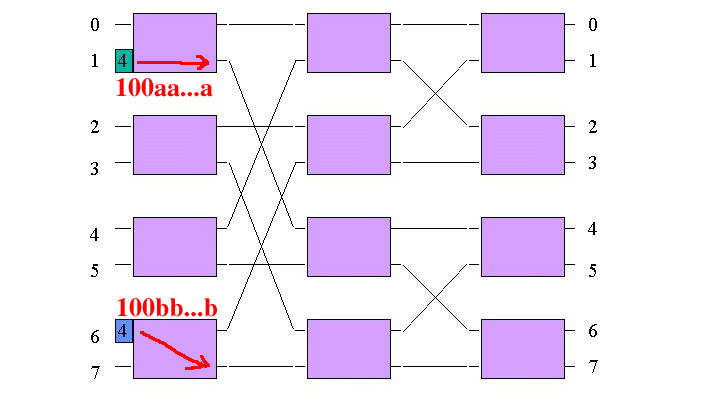
- Step 2:
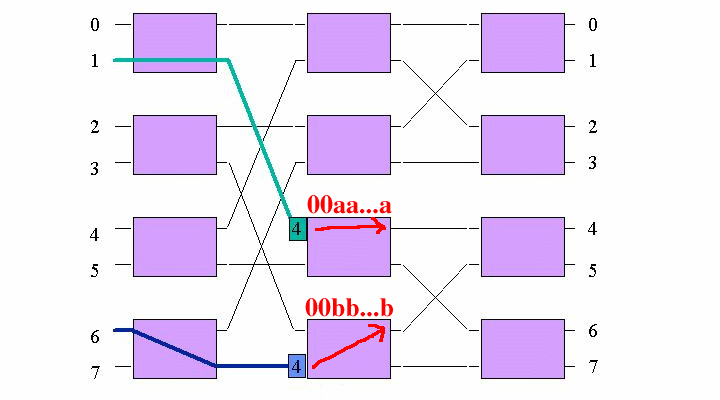
- Step 3:
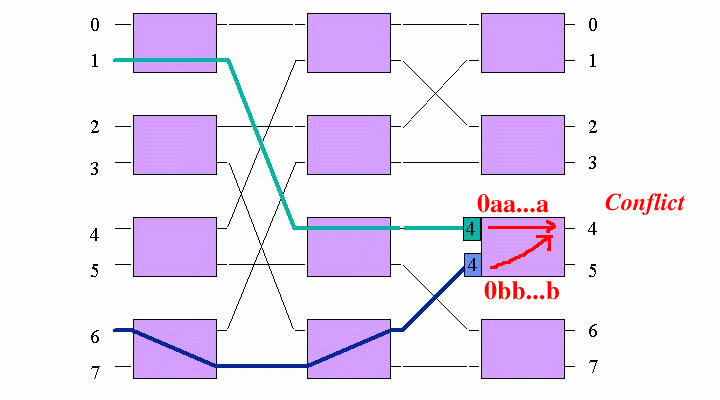
- Switch only forwards ONE of the conflicting
requests:
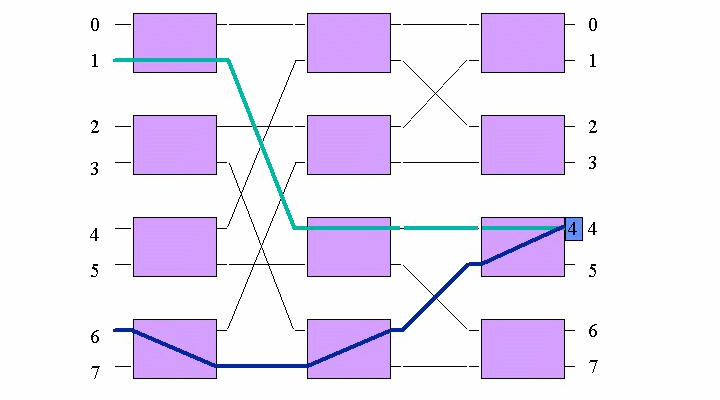
- It is obvious that
multiple requests for the SAME memory module
cannot be satified.
- We saw that the
Cross Bar switch was
non-blocking:
- Simultaneous requests destined for different outputs do not block in a Cross Bar switch.
- Unlike the
Cross Bar switch,
it is also possible
for
2 requests destined for
different memory modules
to be in conflict in the
Delta switch.
- Example:
- CPU 0
wants to send an address value to
Memory Module 2
(2 = 010 )
- CPU 4 wants to send an address value to Memory Module 3 (3 = 011 )
- CPU 0
wants to send an address value to
Memory Module 2
(2 = 010 )
- Step 1:
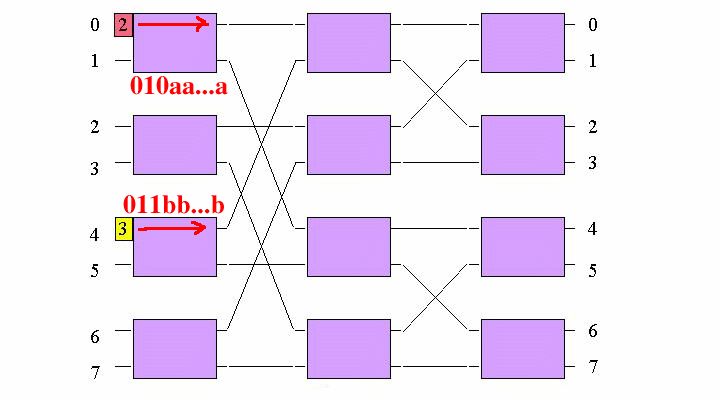
- Step 2:
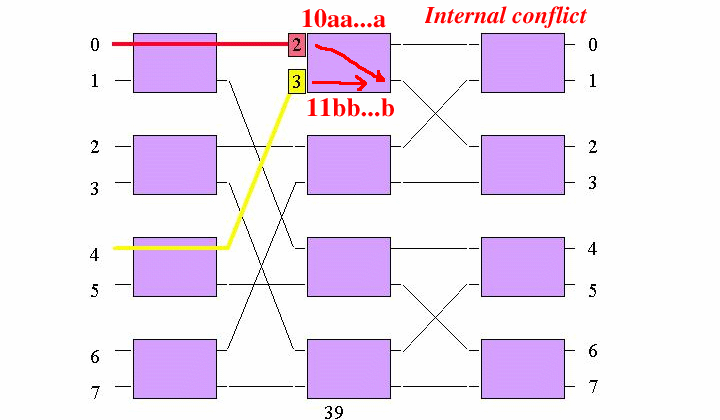
This kind of conflict happens inside the switching fabric and it is called internal blocking requests
- Again, the switch only
forwards ONE of the conflicting
requests:
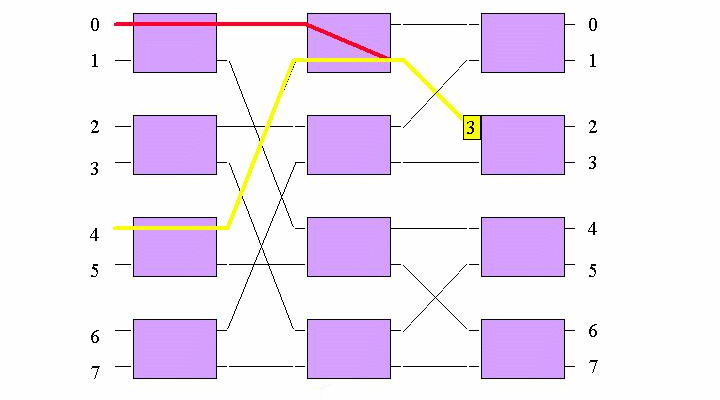
- It's not difficult to understand how the
Delta Switch
perform its "magic".
- In each stage, the Delta Switch
can
discover
the value of each
routing bit
- Consider what happens during the
first stage of the Delta Switch:
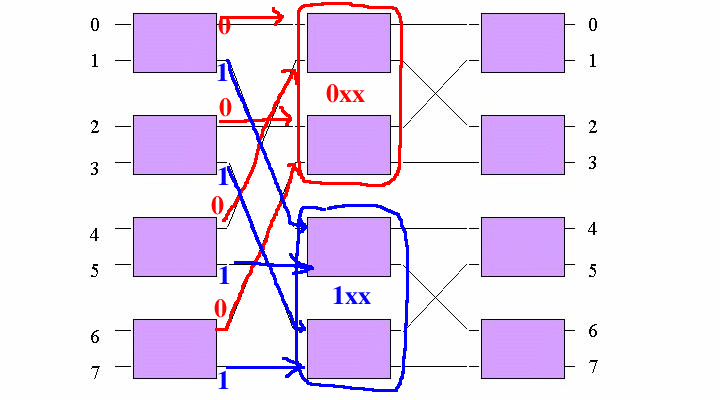
If the routing (first) bit is equal to 0 (zero), then the message is routed towards the TWO UPPER Banyan switches in the SECOND stage
If the routing (first) bit is equal to 1 (one), then the message is routed towards the TWO LOWER Banyan switches in the SECOND stage
- Therefore:
- Messages arriving into the
TWO UPPER Banyan switches
in the SECOND stage
always have a destination address (ID of memory module)
that is equal to
0xx
- Messages arriving into the TWO LOWER Banyan switches in the SECOND stage always have a destination address (ID of memory module) that is equal to 1xx
- Messages arriving into the
TWO UPPER Banyan switches
in the SECOND stage
always have a destination address (ID of memory module)
that is equal to
0xx
- The destination address (ID of memory module)
is then further identified by the
second stage:
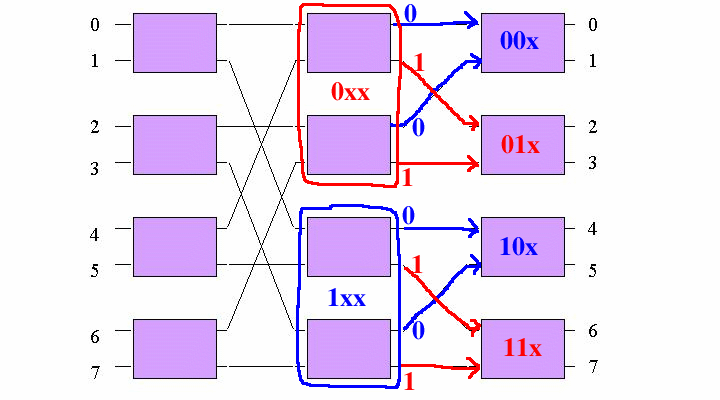
If the routing bit (second bit in address) is equal to 0 (zero), then the message is routed towards the TWO UPPER Banyan switches in the THIRD stage
If the routing bit (second bit in address) is equal to 1 (one), then the message is routed towards the TWO LOWER Banyan switches in the THIRD stage
- Therefore:
- Messages arriving into the
MOST UPPER Banyan switche
in the THIRD stage
always have a destination address (ID of memory module)
that is equal to
00x
- Messages arriving into the
SECOND UPPER Banyan switche
in the THIRD stage
always have a destination address (ID of memory module)
that is equal to
01x
- Messages arriving into the
THIRD UPPER Banyan switche
in the THIRD stage
always have a destination address (ID of memory module)
that is equal to
10x
- Messages arriving into the FOURTH UPPER (most lower) Banyan switche in the THIRD stage always have a destination address (ID of memory module) that is equal to 11x
- Messages arriving into the
MOST UPPER Banyan switche
in the THIRD stage
always have a destination address (ID of memory module)
that is equal to
00x
- The Banyan switches in the third (and final) stage
sorts out the last bit of the address.
(It's so elementary, my dear Watson :-))
Here is how you connect a 16x16 Delta MIN:
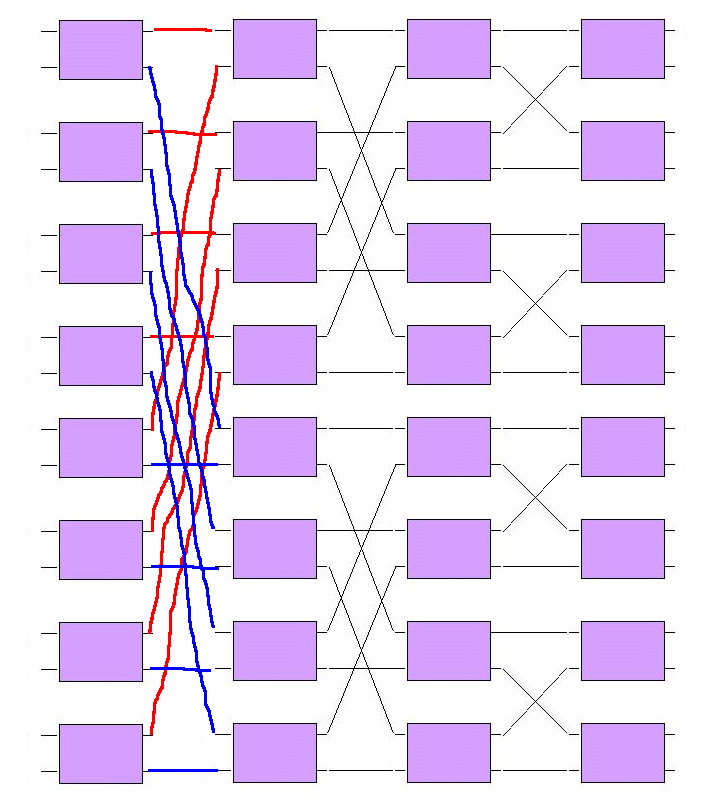
|
- A n x n Delta switch
has log2(n)
number of stages
- The number of switches in the first stage is
n/2
- The number of switches in a
n x n Delta switch
is therefore equal to:
n log(n) ---------- 2